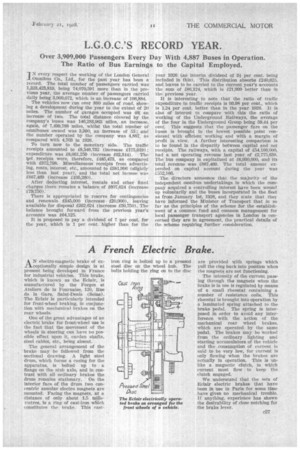L.G.O.C. S RECORD YEAR.
Page 49

If you've noticed an error in this article please click here to report it so we can fix it.
Over 3,909,000 Passengers Every Day With 4,887 Buses in Operation. The Ratio of Bus Earnings to the Capital Employed.
IN every respect the working of the London General 0innibus Co., Ltd., for the past year has been a record. The total number of passengers carried was 1,323,423,819, being 74,070,591 more than in the previous year, the average number of passengers carried daily being 3,909,672, which is an increase of 196,884.
The vehicles now run over 880 miles of road, showing a development during the year to the extent of 20 miles. The number of garages occupied was 40; an increase of two. The total distance covered by the company's buses was 146,283,963 miles, an increase, again, of 7,499,788 miles, whilst the total number of omnibuses owned was 3,990, an increase of 55; and the number operated by the company was 4,887, as compared with 4,703 in 1926.
To turn now to the monetary side. The traffic receipts amounted to £8,546,732 (increase £175,019) ; expenditure was £8,061,259 (increase £62,344). The net receipts were, therefore, £485,473, as compared with £372,798. Miscellaneous receipts from advertising, rents, interest, etc., amounted to £381,996 (slightly less than last year), and the total net income was £867,469 (increase £105,260), After deducting interest, rentals and other fixed charges there remains a balance of £607,624 (increase £79,750).
There is appropriated to reserve for contingencies and renewals £345,000 (increase £20,000), leaving available for disposal £262,624 (increase £59,750). The balance brought forward from the previous year's accounts was £64,125.
It is proposed to pay a dividend of 7 per cent, for the year, which is 1 per cent. higher than for the year 1926 (an interim dividend of 3-i per cent. being included in this). This distribution absorbs £240,625, and leaves to be carried to the current year's accounts the sum of £86,124, which is £21,999 better than in the previous year.
It is interesting to note that the ratio of traffic expenditure to traffic receipts is 03.98 per cent., which is 1.24 per cent. better than in the year 1926. It is also of interest to compare with this the ratio of -working of the Underground Railways, the average of the four in the Underground Group being 59.44 per cent. This suggests that the passenger fare on the buses is brought to tile lowest possible point consistent with efficient working and with a margin of profit in view. A further interesting comparison is to be found in the disparity between capital and net receipts. The railways, with a capital of 154,166,000, had a net operating revenue last year of £2,775,638. The bus company is capitalized at 16,930,000, and its total revenue was £867,469. The total amount expended on capital account during the year was £552,166.
The directors announce that -the majority of the independent omnibus undertakings in which the company acquired a controlling interest have been wound up voluntarily and the buses incorporated in the fleet as from January 1st, 1928, and they state that they have informed the Minister of Transport that in so far as the principles of the scheme for the establishment of a common fund and common management for local passenger transport agencies in London is concerned they are in agreement, the practical details of the scheme requiring further consideration.












































































































